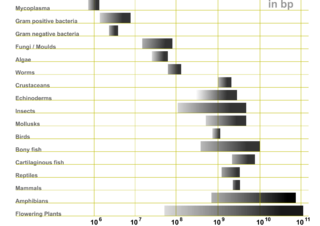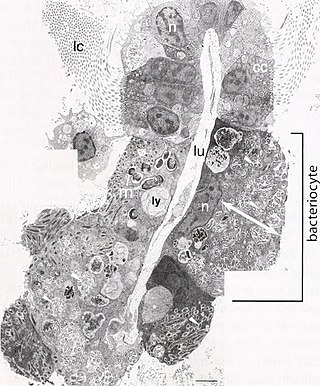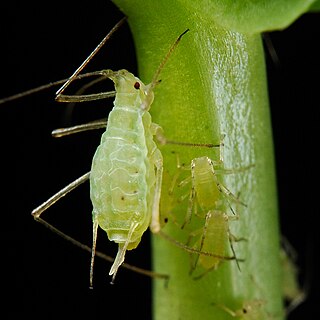Related Research Articles

An endosymbiont or endobiont is any organism that lives within the body or cells of another organism most often, though not always, in a mutualistic relationship. This phenomenon is known as endosymbiosis. Examples are nitrogen-fixing bacteria, which live in the root nodules of legumes, single-cell algae inside reef-building corals and bacterial endosymbionts that provide essential nutrients to insects.

Genome size is the total amount of DNA contained within one copy of a single complete genome. It is typically measured in terms of mass in picograms or less frequently in daltons, or as the total number of nucleotide base pairs, usually in megabases. One picogram is equal to 978 megabases. In diploid organisms, genome size is often used interchangeably with the term C-value.

Buchnera aphidicola, a member of the Pseudomonadota and the only species in the genus Buchnera, is the primary endosymbiont of aphids, and has been studied in the pea aphid, Acyrthosiphon pisum. Buchnera is believed to have had a free-living, Gram-negative ancestor similar to a modern Enterobacterales, such as Escherichia coli. Buchnera is 3 µm in diameter and has some of the key characteristics of its Enterobacterales relatives, such as a Gram-negative cell wall. However, unlike most other Gram-negative bacteria, Buchnera lacks the genes to produce lipopolysaccharides for its outer membrane. The long association with aphids and the limitation of crossover events due to strictly vertical transmission has seen the deletion of genes required for anaerobic respiration, the synthesis of amino sugars, fatty acids, phospholipids, and complex carbohydrates. This has resulted not only in one of the smallest known genomes of any living organism, but also one of the most genetically stable.

A bacteriocyte, also known as a mycetocyte, is a specialized adipocyte found primarily in certain insect groups such as aphids, tsetse flies, German cockroaches, weevils. These cells contain endosymbiotic organisms such as bacteria and fungi, which provide essential amino acids and other chemicals to their host. Bacteriocytes may aggregate into a specialized organ called the bacteriome.
Jeffrey Ivan Gordon is a biologist and the Dr. Robert J. Glaser Distinguished University Professor and Director of the Center for Genome Sciences and Systems Biology at Washington University in St. Louis. He is internationally known for his research on gastrointestinal development and how gut microbial communities affect normal intestinal function, shape various aspects of human physiology including our nutritional status, and affect predisposition to diseases. He is a member of the National Academy of Sciences, the American Academy of Arts and Sciences, the Institute of Medicine of the National Academies, and the American Philosophical Society.

Microbiota are the range of microorganisms that may be commensal, mutualistic, or pathogenic found in and on all multicellular organisms, including plants. Microbiota include bacteria, archaea, protists, fungi, and viruses, and have been found to be crucial for immunologic, hormonal, and metabolic homeostasis of their host.
Blattabacterium is a genus of obligate mutualistic endosymbiont bacteria that are believed to inhabit all species of cockroach studied to date, with the exception of the genus Nocticola. The genus' presence in the termite Mastotermes darwiniensis led to speculation, later confirmed, that termites and cockroaches are evolutionarily linked.

Acyrthosiphon pisum, commonly known as the pea aphid, is a sap-sucking insect in the family Aphididae. It feeds on several species of legumes worldwide, including forage crops, such as pea, clover, alfalfa, and broad bean, and ranks among the aphid species of major agronomical importance. The pea aphid is a model organism for biological study whose genome has been sequenced and annotated.
The hologenome theory of evolution recasts the individual animal or plant as a community or a "holobiont" – the host plus all of its symbiotic microbes. Consequently, the collective genomes of the holobiont form a "hologenome". Holobionts and hologenomes are structural entities that replace misnomers in the context of host-microbiota symbioses such as superorganism, organ, and metagenome. Variation in the hologenome may encode phenotypic plasticity of the holobiont and can be subject to evolutionary changes caused by selection and drift, if portions of the hologenome are transmitted between generations with reasonable fidelity. One of the important outcomes of recasting the individual as a holobiont subject to evolutionary forces is that genetic variation in the hologenome can be brought about by changes in the host genome and also by changes in the microbiome, including new acquisitions of microbes, horizontal gene transfers, and changes in microbial abundance within hosts. Although there is a rich literature on binary host–microbe symbioses, the hologenome concept distinguishes itself by including the vast symbiotic complexity inherent in many multicellular hosts. For recent literature on holobionts and hologenomes published in an open access platform, see the following reference.
The minimal genome is a concept which can be defined as the set of genes sufficient for life to exist and propagate under nutrient-rich and stress-free conditions. Alternatively, it can also be defined as the gene set supporting life on an axenic cell culture in rich media, and it is thought what makes up the minimal genome will depend on the environmental conditions that the organism inhabits. By one early investigation, the minimal genome of a bacterium should include a virtually complete set of proteins for replication and translation, a transcription apparatus including four subunits of RNA polymerase including the sigma factor rudimentary proteins sufficient for recombination and repair, several chaperone proteins, the capacity for anaerobic metabolism through glycolysis and substrate-level phosphorylation, transamination of glutamyl-tRNA to glutaminyl-tRNA, lipid biosynthesis, eight cofactor enzymes, protein export machinery, and a limited metabolite transport network including membrane ATPases. Proteins involved in the minimum bacterial genome tend to be substantially more related to proteins found in archaea and eukaryotes compared to the average gene in the bacterial genome more generally indicating a substantial number of universally conserved proteins. The minimal genomes reconstructed on the basis of existing genes does not preclude simpler systems in more primitive cells, such as an RNA world genome which does not have the need for DNA replication machinery, which is otherwise part of the minimal genome of current cells.
Hamiltonella defensa is a species of bacteria. It is maternally or sexually transmitted and lives as an endosymbiont of whiteflies and aphids, meaning that it lives within a host, protecting its host from attack. It does this through bypassing the host's immune responses by protecting its host against parasitoid wasps. However, H. defensa is only defensive if infected by a virus. H. defensa shows a relationship with Photorhabdus species, together with Regiella insecticola. Together with other endosymbionts, it provides aphids protection against parasitoids. It is known to habitate Bemisia tabaci.

A microbiome is the community of microorganisms that can usually be found living together in any given habitat. It was defined more precisely in 1988 by Whipps et al. as "a characteristic microbial community occupying a reasonably well-defined habitat which has distinct physio-chemical properties. The term thus not only refers to the microorganisms involved but also encompasses their theatre of activity". In 2020, an international panel of experts published the outcome of their discussions on the definition of the microbiome. They proposed a definition of the microbiome based on a revival of the "compact, clear, and comprehensive description of the term" as originally provided by Whipps et al., but supplemented with two explanatory paragraphs. The first explanatory paragraph pronounces the dynamic character of the microbiome, and the second explanatory paragraph clearly separates the term microbiota from the term microbiome.
The microbiota are the sum of all symbiotic microorganisms living on or in an organism. The fruit fly Drosophila melanogaster is a model organism and known as one of the most investigated organisms worldwide. The microbiota in flies is less complex than that found in humans. It still has an influence on the fitness of the fly, and it affects different life-history characteristics such as lifespan, resistance against pathogens (immunity) and metabolic processes (digestion). Considering the comprehensive toolkit available for research in Drosophila, analysis of its microbiome could enhance our understanding of similar processes in other types of host-microbiota interactions, including those involving humans. Microbiota plays key roles in the intestinal immune and metabolic responses via their fermentation product, acetate.

A holobiont is an assemblage of a host and the many other species living in or around it, which together form a discrete ecological unit through symbiosis, though there is controversy over this discreteness. The components of a holobiont are individual species or bionts, while the combined genome of all bionts is the hologenome. The holobiont concept was initially introduced by the German theoretical biologist Adolf Meyer-Abich in 1943, and then apparently independently by Dr. Lynn Margulis in her 1991 book Symbiosis as a Source of Evolutionary Innovation. The concept has evolved since the original formulations. Holobionts include the host, virome, microbiome, and any other organisms which contribute in some way to the functioning of the whole. Well-studied holobionts include reef-building corals and humans.

Cospeciation is a form of coevolution in which the speciation of one species dictates speciation of another species and is most commonly studied in host-parasite relationships. In the case of a host-parasite relationship, if two hosts of the same species get within close proximity of each other, parasites of the same species from each host are able to move between individuals and mate with the parasites on the other host. However, if a speciation event occurs in the host species, the parasites will no longer be able to "cross over" because the two new host species no longer mate and, if the speciation event is due to a geographic separation, it is very unlikely the two hosts will interact at all with each other. The lack of proximity between the hosts ultimately prevents the populations of parasites from interacting and mating. This can ultimately lead to speciation within the parasite.

The Drosophila quinaria species group is a speciose lineage of mushroom-feeding flies studied for their specialist ecology, their parasites, population genetics, and the evolution of immune systems. Quinaria species are part of the Drosophila subgenus.
Vertical transmission of symbionts is the transfer of a microbial symbiont from the parent directly to the offspring. Many metazoan species carry symbiotic bacteria which play a mutualistic, commensal, or parasitic role. A symbiont is acquired by a host via horizontal, vertical, or mixed transmission.

All animals on Earth form associations with microorganisms, including protists, bacteria, archaea, fungi, and viruses. In the ocean, animal–microbial relationships were historically explored in single host–symbiont systems. However, new explorations into the diversity of marine microorganisms associating with diverse marine animal hosts is moving the field into studies that address interactions between the animal host and a more multi-member microbiome. The potential for microbiomes to influence the health, physiology, behavior, and ecology of marine animals could alter current understandings of how marine animals adapt to change, and especially the growing climate-related and anthropogenic-induced changes already impacting the ocean environment.

The holobiont concept is a renewed paradigm in biology that can help to describe and understand complex systems, like the host-microbe interactions that play crucial roles in marine ecosystems. However, there is still little understanding of the mechanisms that govern these relationships, the evolutionary processes that shape them and their ecological consequences. The holobiont concept posits that a host and its associated microbiota with which it interacts, form a holobiont, and have to be studied together as a coherent biological and functional unit to understand its biology, ecology, and evolution.

Snodgrassella alvi is a species of Gram-negative bacteria within the Neisseriaceae and was previously the only known species of the genus Snodgrassella. It was isolated and scientifically described in 2012 by Waldan K. Kwong and Nancy A. Moran, who named the bacteria after the American entomologist Robert Evans Snodgrass.
References
- 1 2 3 4 5 6 7 8 9 10 11 12 13 14 15 16 17 Zagorski, N. (2005). "Profile of Nancy A. Moran". Proceedings of the National Academy of Sciences. 102 (47): 16916–16918. Bibcode:2005PNAS..10216916Z. doi: 10.1073/pnas.0508498102 . PMC 1288003 . PMID 16286644.
- ↑ "Moran Lab • Ecology and Evolutionary Biology • Yale University". Archived from the original on 2011-08-05. Retrieved 2011-07-28.
- ↑ "Carrots Share Trait With Tiny Pea Aphid", The New York Times, HENRY FOUNTAIN, May 3, 2010
- 1 2 "Nancy Moran University of Texas at Austin". web.biosci.utexas.edu. Retrieved 2017-11-24.
- ↑ Burley, Nancy; Moran, Nancy (1979). "The significance of age and reproductive experience in the mate preferences of feral pigeons, Columba livia". Animal Behaviour. 27: 686–698. doi:10.1016/0003-3472(79)90005-8. ISSN 0003-3472. S2CID 53202864.
- 1 2 "NANCY MORAN" . Retrieved April 1, 2019.
- ↑ Moran, N. A. (1989). "A 48-Million-Year-Old Aphid--Host Plant Association and Complex Life Cycle: Biogeographic Evidence". Science. 245 (4914): 173–175. Bibcode:1989Sci...245..173M. doi:10.1126/science.245.4914.173. ISSN 0036-8075. PMID 17787877. S2CID 2710577.
- ↑ Munson, Mark A.; Baumann, Paul; Morant, Nancy A. (1992). "Phylogenetic relationships of the endosymbionts of mealybugs (Homoptera: Pseudococcidae) based on 165 rDNA sequences". Molecular Phylogenetics and Evolution. 1 (1): 26–30. doi:10.1016/1055-7903(92)90032-C. ISSN 1055-7903. PMID 1342920.
- 1 2 Moran, N. A. (1996). "Accelerated evolution and Muller's rachet in endosymbiotic bacteria". Proceedings of the National Academy of Sciences. 93 (7): 2873–2878. Bibcode:1996PNAS...93.2873M. doi: 10.1073/pnas.93.7.2873 . ISSN 0027-8424. PMC 39726 . PMID 8610134.
- ↑ Tamas, I. (2002). "50 Million Years of Genomic Stasis in Endosymbiotic Bacteria". Science. 296 (5577): 2376–2379. Bibcode:2002Sci...296.2376T. doi:10.1126/science.1071278. ISSN 0036-8075. PMID 12089438. S2CID 19226473.
- ↑ McCutcheon, John P.; Moran, Nancy A. (2011). "Extreme genome reduction in symbiotic bacteria". Nature Reviews Microbiology. 10 (1): 13–26. doi:10.1038/nrmicro2670. ISSN 1740-1526. PMID 22064560. S2CID 7175976.
- ↑ Moran, Nancy A. (2002). "Microbial Minimalism". Cell. 108 (5): 583–586. doi: 10.1016/S0092-8674(02)00665-7 . ISSN 0092-8674. PMID 11893328. S2CID 18688744.
- 1 2 3 Martinson, Vincent G.; Carpinteyro-Ponce, Javier; Moran, Nancy A.; Markow, Therese A. (2017-09-22). "A distinctive and host-restricted gut microbiota in populations of a cactophilic Drosophila species". Applied and Environmental Microbiology. 83 (23): e01551-17. Bibcode:2017ApEnM..83E1551M. doi:10.1128/AEM.01551-17. ISSN 1098-5336. PMC 5691420 . PMID 28939605.
- 1 2 3 4 Zheng, Hao; Powell, J. Elijah; Steele, Margaret I.; Dietrich, Carsten; Moran, Nancy A. (2017-05-02). "Honeybee gut microbiota promotes host weight gain via bacterial metabolism and hormonal signaling". Proceedings of the National Academy of Sciences of the United States of America. 114 (18): 4775–4780. doi: 10.1073/pnas.1701819114 . ISSN 1091-6490. PMC 5422775 . PMID 28420790.
- 1 2 Kwong, Waldan K.; Medina, Luis A.; Koch, Hauke; Sing, Kong-Wah; Soh, Eunice Jia Yu; Ascher, John S.; Jaffé, Rodolfo; Moran, Nancy A. (March 2017). "Dynamic microbiome evolution in social bees". Science Advances. 3 (3): e1600513. Bibcode:2017SciA....3E0513K. doi:10.1126/sciadv.1600513. ISSN 2375-2548. PMC 5371421 . PMID 28435856.
- 1 2 Raymann, Kasie; Shaffer, Zack; Moran, Nancy A. (March 2017). "Antibiotic exposure perturbs the gut microbiota and elevates mortality in honeybees". PLOS Biology. 15 (3): e2001861. doi: 10.1371/journal.pbio.2001861 . ISSN 1545-7885. PMC 5349420 . PMID 28291793.
- ↑ "American Academy of Arts & Sciences Directory" . Retrieved April 1, 2019.
- ↑ "AAAS Fellows" (PDF). Retrieved April 1, 2019.
- ↑ "University of Arizona Alumni Association". August 2013. Retrieved April 1, 2019.
- ↑ "Yale Evolutionary Biologist Nancy Moran Wins Coveted Japanese Science Prize". 8 October 2010. Retrieved April 1, 2019.
- ↑ "Jim Tiedje Award" . Retrieved April 1, 2019.
- ↑ "Motoo Kimura Lifetime Contribution Award" . Retrieved April 1, 2019.
- ↑ Jeremy Yoder (May 31, 2017). "Nancy Moran awarded the 2017 Molecular Ecology Prize" . Retrieved April 1, 2019.
- ↑ "Selman A. Waksman Award in Microbiology".
- ↑ McCutcheon, John P.; von Dohlen, Carol D. (2011). "An Interdependent Metabolic Patchwork in the Nested Symbiosis of Mealybugs". Current Biology. 21 (16): 1366–1372. doi:10.1016/j.cub.2011.06.051. ISSN 0960-9822. PMC 3169327 . PMID 21835622.